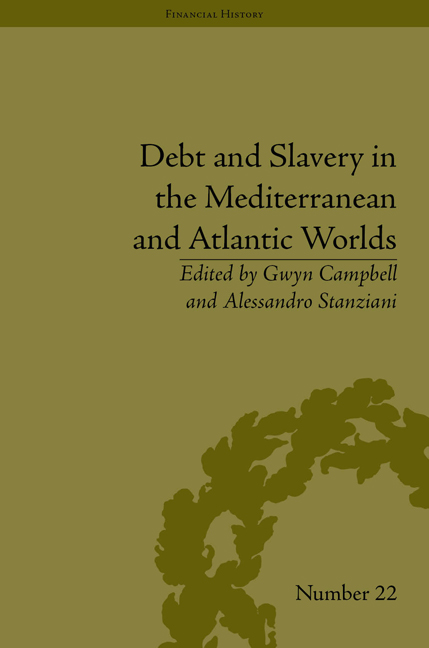Book contents
- Frontmatter
- Contents
- Acknowledgements
- List of Contributors
- Introduction
- 1 Debt Bondage and Chattel Slavery in Early Rome
- 2 Slavery, Debt and Bondage: The Mediterranean and the Eurasia Connection from the Fifteenth to the Eighteenth Century
- 3 Clientship, Social Indebtedness and State-Controlled Emancipation of Africans in the Late Ottoman Empire
- 4 Pawnship and Seizure for Debt in the Process of Enslavement in West Africa
- 5 The Business of ‘Trust’ and the Enslavement of Yoruba Women and Children for Debt
- 6 The Africanization of the Workforce in English America
- 7 Credit, Captives, Collateral and Currencies: Debt, Slavery and the Financing of the Atlantic World
- 8 Unpayable Debts: Reinventing Bonded Labour through Legal Freedom in Nineteenth-Century Brazil
- 9 Indigenous Debt and the Spirit of Colonial Capitalism: Debt, Taxes and the Cash-Crop Economy in the Anglo-Egyptian Sudan, 1898–1956
- Notes
- Index
2 - Slavery, Debt and Bondage: The Mediterranean and the Eurasia Connection from the Fifteenth to the Eighteenth Century
- Frontmatter
- Contents
- Acknowledgements
- List of Contributors
- Introduction
- 1 Debt Bondage and Chattel Slavery in Early Rome
- 2 Slavery, Debt and Bondage: The Mediterranean and the Eurasia Connection from the Fifteenth to the Eighteenth Century
- 3 Clientship, Social Indebtedness and State-Controlled Emancipation of Africans in the Late Ottoman Empire
- 4 Pawnship and Seizure for Debt in the Process of Enslavement in West Africa
- 5 The Business of ‘Trust’ and the Enslavement of Yoruba Women and Children for Debt
- 6 The Africanization of the Workforce in English America
- 7 Credit, Captives, Collateral and Currencies: Debt, Slavery and the Financing of the Atlantic World
- 8 Unpayable Debts: Reinventing Bonded Labour through Legal Freedom in Nineteenth-Century Brazil
- 9 Indigenous Debt and the Spirit of Colonial Capitalism: Debt, Taxes and the Cash-Crop Economy in the Anglo-Egyptian Sudan, 1898–1956
- Notes
- Index
Summary
The history of bondage in Eurasia provides useful insights into the link between various forms of bondage and war captives, on the one hand, and slavery on the other hand. Two main sources are usually mentioned in studies of ancient, medieval and modern slavery: debt (widely conceived as a form of individual and/or social obligation) and capture by war parties or belligerent armies. Roughly speaking, the fist is somewhat internal to a given society while the second is generated through transgression of territorial boundaries.
This taxonomy requires some important qualifications; for example, war captives may be offered for ransom, but they may also enter the category of slaves by being sold: sale of captives within the internal market of the victorious war party was quite widespread. However, this shift requires the agreement of the leaders of the clan or of the state. That is to say that the boundary between a war captive and a debt slave is flexible and depends on the relative power of military commanders, political leaders, slave brokers and slave owners in negotiating amongst themselves the disposition of war captives.
In turn, debt and ‘obligated’ slaves cover a much wider and debated category extending from debt bondage to voluntary or involuntary enslavement and finally to pawnship. In this respect, Eurasia and the Mediterranean provide a stimulating historical environment in which to discuss the appropriateness of the terminology adumbrated above and whether envisioning the phenomena encompassed by such wording is warranted historically.
- Type
- Chapter
- Information
- Publisher: Pickering & ChattoFirst published in: 2014



